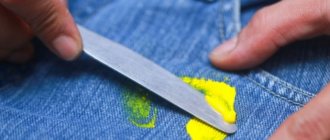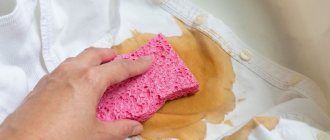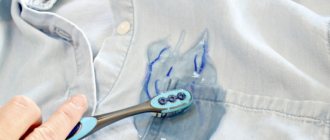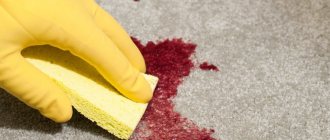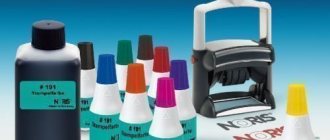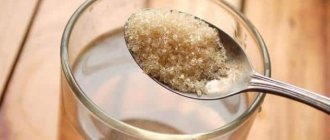A paint stain on clothing may appear as a result of careless handling of a painted item or as a result of repair work. Try washing, scrubbing or removing stains with our tips on how to quickly remove dye from clothes before throwing it away. First you need to decide what substance got on the fabric. The material and its composition also matter. The method that you choose thanks to our recommendations will help the stain disappear without a trace without much effort.
- First aid for items with fresh paint stains
- Removing old stains
- Removing oil enamel
- Removing acrylic and water-based paints
- Hair dye removal
- Eliminating the consequences of the festival of colors
- How to remove stains from different fabrics
Basic rules for cleaning fabrics yourself
Before attempting to remove paint from clothes, remember the following rules:
- if the item is expensive, it is better not to experiment, but to take it to the dry cleaner;
- It is necessary to clean the stain as soon as possible - as time passes, it is removed worse;
- start from an inconspicuous edge of the soiled item to check whether this product will not damage the material;
- After cleaning, machine wash is required.
Washing in a machine is a mandatory step in removing dye from fabric.
Special means
You can get rid of paint using special stain removers. They are sold in stores in the departments with household chemicals.
When choosing a product, you need to pay attention to the following points:
Release form . Liquid formulations are universal, and powder detergents are not used for washing delicate items.- Purpose of the product . There are stain removers only for white and only for colored items.
- Compound. It may include surfactants, enzymes, and active oxygen. These components carefully remove dirt without harming the fabric fibers. Aggressive substances include: chlorine, bile, acids.
Be sure to pay attention to the price of the cleaning product. Often it is overestimated not because of the effectiveness of the stain remover, but because of the brand under which it is produced.
General instructions for use:
- apply the composition to the stain (if powder is used, the fabric must first be moistened);
- leave for impact;
- rub the contaminated area;
- Wash your pants using stain remover.
Top 3 best products
You can deal with paint using the following stain removers:
- Vanish Oxi action Gold gel . Apply the product to the stain, leave for 1-4 hours, then wash as usual. The cost of a 0.45 liter bottle is 210 rubles.
Advantages of the stain remover: convenient release form, activation at low temperatures, ability to use for white and colored items, absence of aggressive components in the composition.
Gel Antipyatin with natural bile .
Apply the product to the stain, rub in gently, leave for 15 minutes, then wash by hand or in a machine. The cost of a 250 ml package is 230 rubles. Advantages: activation at a temperature of 30 degrees, the ability to use for washing delicate items, the presence of natural ingredients. Udalix Ultra liquid stain remover . The spray is sprayed onto the stain, left to act for 10-15 minutes, rubbed lightly with your hands, and washed as usual.
The cost of a 150 ml spray is 260 rubles. Advantages: convenient bottle that allows you to accurately dose the product, can be used for all types of fabrics.
Features of removing old stains
If the stain appeared a long time ago, it is more difficult to remove paint at home: it eats into the fabric. To make it easier for you to clean up the stained area, we have collected tips:
- You cannot rub too hard, this harms the material and increases the area of the dirty area;
- be sure to test whether the chosen cleaning method is suitable for the fabric of the product;
- Always wash dirty areas from the edges to the center.
It’s rare that you can quickly and effectively remove old stains in one go. You may have to wash the fabric more than once in soapy water, dry it, and clean it again. You can repeat this until it is completely clean.
Basic rules on how and what to remove paint from pants without ruining them
It is pants that most often suffer from paint. You can put a stain anywhere, for example, by sitting on a bench in the park and staining the thing with paint from the bench.
If you discover contamination, there is no need to despair. The thing can be completely rehabilitated. Both improvised means and professional stain removers come to the rescue.
Let's look in more detail at how and with what you can remove fresh and already dried paint from pants (white, black, etc.) at home.
How to deal with oil dye
To remove oil paint from clothes, try using inexpensive home remedies first.
Vegetable oil
A fairly common problem: an oil paint stain on trousers that appears from a recently painted street bench, if an inattentive person sat (or sat) on the painted bench.
If the problem is noticed in time and the stain is fresh, then it is relatively easy to remove. The simplest way to remove dye is vegetable oil. The oil will soften the dirt and prevent it from drying out.
After soaking, traces of dye must be removed with a brush.
Dishwashing liquid
You can get rid of an oil stain by rubbing dishwashing liquid into the stain. After half an hour, the clothes are washed.
Starch
- Stains on trousers from a freshly painted bench can be cleaned with starch. The pants are placed with the dirt facing up.
- Place a blank sheet of paper underneath.
- Starch is poured onto the dirt and covered with paper.
- The area prepared in this way is ironed.
After this treatment, the starch will immediately remove most of the dye and simply absorb it. The rest will come off when washed.
Starch is a natural stain remover.
Gasoline, acetone, turpentine
It is possible to wash oil paint with strong solvents: turpentine, acetone or gasoline. Choose one of these substances and treat the dirty area with it, gently rubbing it in. Afterwards, wash under water at room temperature and wash.
Attention!
This method is not used for delicate fabrics: solvents will discolor them.
Liquid soap
You can clean painted areas with liquid soap:
- Straighten the fabric that needs cleaning;
- put unnecessary rags down;
- Pour plenty of soap over the area to be treated;
- leave for 20 minutes;
- then wash it.
Comprehensive cleaning
Scraping paint from clothes.
It is suitable for rough materials. To achieve results at home, cleaning is carried out as follows.
- Mechanical restoration.
Use a nail file or a stiff brush to remove the top dried layer.
2. Solvent treatment.
Moisten the dirty area with gasoline, acetone, and liquid soap.
3. Soaking.
Leave the product soaked in the solvent for half an hour.
!Enameled dishes are not suitable for soaking in solvent.
4. Mechanical processing.
Rub the fabric with a washcloth.
5. Washing.
Rinse the treated product in clean water.
Margarine
This product helps to wash off dye from a sweater or pants, even if the stain is old: margarine simply softens it.
After treating the area with margarine, you should wait half an hour, then wash the product.
Video How to remove paint stains
Leather item
Fresh stains on the skin can be quickly removed using regular dishwashing liquid:
- Make an aqueous solution;
- Treat the contaminated area of skin with the product;
- Wipe with a clean damp cloth;
- Lubricate the area with skin fluid.
What to do with an old stain on the skin? This material can be cleaned using regular vegetable oil. You need to soak a piece of cloth or a cotton swab in oil and wipe off the contaminated area.
The paint will not come off right away, so be patient. To make things go faster, mix the oil with leather cleaner.
How to remove acrylic paint from clothes
Fresh acrylic paint washes off quickly and easily, but the fact is that it dries within an hour after application. And then it is much more difficult to remove it.
- This property is due to the composition of acrylic paints:
- water;
- coloring pigment;
- acid in small quantities;
- a film former that ensures drying.
Therefore, try to remove acrylic stains while they are fresh, within an hour. If this was not possible, and the places of contamination are old and dry, then there are other methods.
Mechanical impact
You can remove paint stains at home using mechanical action.
- Scrape off the old paint with a knife, file, or spoon.
This method is used if you need to remove old dirt when it has already dried.
2. Blot with a napkin until the acrylic is absorbed.
It is used if the acrylic stain has not yet dried. You can’t rub it, you can only gently blot it.
3. Clean with a brush.
Recommended if the dye is sprayed in small drops.
!Refrain from using a brush on delicate materials.
Isopropyl alcohol
You can clean clothes with isopropyl alcohol.
- Straighten the item of clothing well.
- Place a rag under the stain.
- Moisten the sponge well with alcohol.
- Sponge the stain.
As the acrylic is wetted with isopropyl, it will begin to soften and clean off.
Isopropyl alcohol softens paint.
Ammonia, vinegar, salt
To clean such paints at home, follow the instructions. You should:
- soak the item in ice water;
- in another bowl, combine equal parts of vinegar, ammonia, add a pinch of salt;
- squeeze out the soaked material, spread it out, straighten it;
- moisten a clean sponge in the ammonia mixture;
- Rub the desired area with a washcloth until it is clean.
īAfter dissolving the acrylic, be sure to thoroughly rinse and wash.
Dishwashing liquid
There is no way to remove dried paint. The product will only deal with fresh stains.
- Rinse the fabric well in clean water.
- Apply detergent with a sponge; it will soften the acrylic.
- Gently scrape the knife along the acrylic, removing any residue.
- To finish cleaning, wash the fabric.
Treat paint stains with dishwashing detergent.
Hairspray with acetone
Paint stains can be cleaned using this method as follows:
- the thing unfolds and straightens out;
- the dirty place is sprayed with varnish;
- the sprayed area is moistened with acetone;
- dissolved dirt is removed with a washcloth.
Attention!
This method is not used for synthetic fabrics.
Acetone or nail polish remover containing acetone
You can also remove the stain yourself with acetone. You can use acetone to remove paint stains only for natural fabrics (such as cotton, linen) with stable coloring.
- Soak a clean cotton swab in solvent;
- process a thing with it;
- After the dye has dissolved, the item of clothing must be washed.
Medical alcohol
Another handy solvent - medical alcohol - will help you get rid of paint from clothes at home.
Rubbing alcohol will only remove fresh stains.
- Straighten the item of clothing and carefully lay it flat;
- place an unnecessary clean cloth under it;
- Moisten the area of contamination well with ethanol;
- stand for 10 minutes.
After soaking, carefully remove dirt with a clean sponge.
Rubbing alcohol is suitable for cleaning fresh paint stains.
Refined gasoline
It is important not only to know how to remove traces of paint, but also how not to spoil the fabric and preserve its texture and color. Refined gasoline is a good helper in this matter.
- Moisten a household sponge with gasoline.
- Wipe off the dirt until the sponge itself begins to get dirty from the absorbed acrylic.
- If the sponge becomes dirty, replace it with a new, clean one.
- The treatment is carried out until the dirt is completely dissolved.
Attention!
The procedure should be carried out in a ventilated area to avoid intoxication.
Acrylic remover
The product can be used to remove paint on acrylic, but only on natural dense fabrics such as cotton and linen.
- Saturate the sponge with liquid.
- Treat the area to be cleaned.
The washcloth is replaced with a new one as it becomes dirty and absorbs the dissolved dye.
How to remove paint from clothes - use acrylic paint solvent Video
Stain remover Vanish
Another way to remove colors from clothes is “Vanish”.
- Add Vanish to the soaking water.
- Immerse soiled clothing in the solution.
- Leave for 5-10 minutes.
- The dye will soften, making it possible to wash off most of the dirt by hand.
- Place the salvaged item in the washing machine.
Vanish is a ready-made product for removing paint from clothes.
Alcohol and salt
This method can remove paint stains from synthetics without going to the dry cleaner. Cleansing is carried out as follows:
- Heat alcohol in one container and add a sliver of salt;
- make a strong saline solution in a separate container;
- the desired area is generously moistened with the prepared alcohol and left for 15 minutes;
- using a sponge, treat the alcohol-soaked area with saline solution;
- The procedure is completed by machine washing.
other methods
There are other options than cleaning clothes at home without ruining the color or texture of the fabric. For example:
- Scotch tape - suitable for dried stains on linen or cotton ;
- sunflower oil, bar soap, hot water - if the contamination is fresh ;
- strong chemical solvents - for old dirt .
First aid for items with fresh paint stains
paint stain
The faster a stain is detected, the greater the chance of removing it completely. You shouldn’t take the first product you come across and use it. Any substance must be applied to the fabric from the inside out, placing the paper on the front side. Napkins or paper towels are perfect for this purpose. This will prevent paint from penetrating deep into the fabric. The stain should be removed from the edges to the center to prevent it from spreading and running.
To choose the best way to get rid of a stain, you should set the type of dye. Types of paints that can get on clothes:
- watercolor;
- gouache;
- acrylic;
- water-based;
- oil;
- enameled;
- hair dye.
Do you wash by hand?
Oh yes! No
Having determined the type of substance, you can begin the procedure to remove the stain. It is important to follow the correct sequence of actions to ensure maximum results:
- Preparing the home work surface. Often, dangerous solutions are required to remove paint from things: acetone, kerosene, gasoline, white spirit and others. Certain safety rules should be followed: act in a well-ventilated area, for example, on a balcony or loggia.
- The work area should be covered with oilcloth or cling film. It is advisable to put a white thick fabric on top.
- Processing of the material should not be carried out on surfaces that have been painted (a layer of paint may come off from them). Parquet and laminate are also excluded: stains remain on these materials.
- Before removing paint marks, test the selected product on a corner of the garment and evaluate the reaction of the fabric.
How to get rid of latex paint
If you have stained your clothes with latex paint, the best option is to not let the latex stain dry and clean off the dirt immediately.
With medical alcohol
Alcohol dissolves latex well. If you soak a latex stain with alcohol for 10 minutes, then remove the dissolved latex with a clean cloth, you will be able to remove the paint from clothing almost completely. Regular washing will complete the rest.
Washing powder and long-term washing
Fresh stains can be removed quite successfully by washing powder. The soiled item is left in clean ice water for half an hour. Afterwards, the item is wrung out and washed with powder at low temperature (30 degrees) on a program with the longest cycle possible.
Long-term machine washing removes fresh paint stains.
Washing powder, toothbrush and laundry
Old stains must first be cleaned as much as possible using a soft toothbrush:
- Apply powder to the wet spot;
- Scrub the dirt with a toothbrush;
- wash the dirty area of the product in hot water;
- wash the item in the machine.
Enemies of acrylic
If acrylic paint appeared on clothes a long time ago, it will be difficult to deal with it. Try using solvent solvents and then use an ammonia-vinegar mixture.
Ammonia and vinegar
Peculiarities. A mixture of ammonia and vinegar will also help remove acrylic paint stains from clothes. To enhance the effect, add regular table salt to the main components.
Let's start washing
- Mix vinegar and ammonia. The components must be taken in the same quantity - two tablespoons each.
- Add salt to the mixture. You will need about a tablespoon, but you can use your eye - the paste should turn out runny.
- Apply the mixture to the stained cloth.
- Scrub gently with an old toothbrush.
- Wash it. Use the normal wash cycle for the garment.
Video on the topic
How to clean water-based paint
It is quite simple to remove paint from clothes if it is stained with water-based emulsion. It can be washed by hand or by exposure to ethanol.
Handwash
- Moisten the contaminated area with water.
- Apply cleaning agent.
- Wipe off dirt with your hands or a soft brush.
Attention!
Carry out the procedure in a ventilated area to avoid intoxication. Do not use a brush on delicate fabrics.
Can be used:
- powder;
- stain remover;
- bar soap.
Bar soap can be used to remove water-based paint from clothing.
Alcohol-based antiseptic wipes
If the stain is fresh, but cannot be removed immediately, you can have success using alcohol wipes.
The dirt will either be completely removed immediately or washed off during washing.
Water emulsion
This paint often contains resins, which give it greater resistance to external influences, in particular to solvents and water.
But water-based emulsion responds well to chemical solvents:
- Kerosene;
- Alcohol;
- Vinegar;
- Ammonia.
If the water-based emulsion does not contain resins, it can be quickly washed with ordinary soap solution or powder. Of course, it is not always possible to know the composition of the paint in advance, so try to wash the stain with detergents first, and then use chemicals.
How to wash off watercolor
It is not difficult to wash watercolor: it can be removed with improvised means.
Washing powder, laundry soap
- Soak the fabric in ice water.
- Watercolors can be washed by hand with powder or bar soap.
It is better not to wait time before processing.
īThe sooner you start, the greater the chance of washing your clothes clean.
You can remove watercolors from clothes using powder and hand washing.
Laundry soap with soda
Cotton and linen can be cleaned this way.
Compound:
- 1 liter of water;
- 1 tbsp soda;
- 1/2 bar of laundry soap, grated.
Sequencing:
- Boil the mixture.
- Soak the product in it for 15 minutes.
- Then rinse.
You can cleanse in several circles.
Soap and denatured alcohol
To remove watercolor marks yourself using this method you need:
- wash the stained area with soap;
- heat technical alcohol;
- wipe the desired areas with heated liquid;
- remove traces of alcohol by washing in warm water;
- wash the item using the usual method.
Ammonia and salt
This way you can remove watercolor marks from synthetic materials. For this:
- treat the stained area with ammonia;
- put the item aside for 5 minutes;
- prepare saline solution: 2 tsp. salt per 1 liter of water;
- soak the fabric in the prepared liquid;
- wash the soaked one.
High quality baby powder
What else can be used to clean watercolors is baby powder. The washing cycle is repeated twice.
!If the dirt is large, you can rub it off with powder manually.
Soda with peroxide
Wash watercolors with this solution:
- 100 ml water;
- 100 gr. soda;
- 100 ml peroxide.
Treat the desired area with the mixture, then wash the entire product.
Baking soda and hydrogen peroxide are a mixture for removing watercolors.
Vinegar
Vinegar is another product that can be used to wash natural dense fabric materials.
- Heat the acid.
- Moisten the contaminated area with acid.
- Then rinse the clothes.
- Wash as usual.
Stain removers
These products are what you can use to remove watercolor marks at home without damaging the color of the fabric. You will not spoil the material if you select a stain remover for it according to the instructions. Most often bought:
- Vanish;
- Bos;
- Antipyatin;
- Amway;
and etc.
Glycerol
They can easily remove dye from the fabric of trousers or sweaters. The dirt is treated with a sponge in glycerin, after 15 minutes the item is washed in soapy water.
Glycerin is suitable for removing dye from trouser fabric.
Boiling
The method is used when pants are damaged by watercolors: they are made of rough, dense fabric and will survive such exposure.
You can clean them by boiling them in the mixture:
- water 1 liter;
- 1 tbsp. crushed bar soap;
- ammonia 20g;
- hydrogen peroxide 20 g;
- soda 20 g.
You need to boil the trousers for half an hour, then take them out and rinse.
First aid
The easiest way to deal with a fresh stain. Any paint that has just spilled onto your pants can be easily removed with regular washing powder.
Algorithm of actions to follow:
- moisten the stain with water or apply a damp disposable cloth to it;
- Apply washing powder to the stain;
- rub with a brush until soap foam forms;
- leave to soak for 15-30 minutes;
- wash your trousers as usual.
This method is only suitable if the paint is on the pants for no more than 1-2 hours.
Gouache
You can get rid of gouache at home using improvised means.
Using soap
A fresh stain will be cleaned in one go by hand washing with bar soap.
For old ones, several cycles will be needed.
Glycerin with ammonia
You can clean your clothes with a homemade cleaning agent: glycerin and ammonia are combined in equal parts.
- Apply the mixture to the area of contamination.
- Leave for half an hour.
- Then wash off with soapy water.
Toothpaste
You can clean clothes stained with watercolors using toothpaste. You can rub it with your hands or a brush. The cleaning cycle may need to be repeated several times.
Mustard powder
- Dilute mustard powder with water to form soft clay.
- Distribute over the area contaminated with gouache, previously moistened with water.
- Leave for 20 minutes.
Important!
Constantly sprinkle the mixture with water, preventing it from drying out.
4. Rinse clothes, washing off the mustard mixture.
5. Put it in the wash.
Eucalyptus oil
You can use a herbal remedy to remove gouache from wardrobe items. This is done like this: moisten it with oil, leave it for 10 minutes, then wash the item with soap and hands.
Eucalyptus oil is a herbal remedy for removing gouache.
White Spirit
They can also wash off gouache. You need to proceed as in other cases: wipe the desired area with a sponge and solvent; do not use for delicate, thin fabrics.
Using soda
After the initial washing, pour soda onto the dirty area and leave for 15 minutes. She will remove the gouache.
Washing powder and butter
These ingredients are used to make a paste that is rubbed into the contaminated area. After half an hour the item is washed.
Dishwashing liquid
The dampened fabric is washed with dishwashing gel, but the foam is not washed off immediately, it is left for half an hour.
After the next wash, the gouache is washed off.
Nail polish remover
Suitable with or without acetone. The method is not recommended for synthetic fabric materials. Clothes are washed by hand, and any remaining gouache is removed with nail polish remover.
Stamp paint
Clerical office workers periodically have difficulty removing stamp ink stains after carelessly refilling seals or stamps. To remove them at home, the following methods are proposed:
- Mix mustard powder with water until a paste forms. Cover the stain with it and leave for 24 hours. After a day, scrape off the dried pulp and put the item in the wash. This method is also suitable for delicate fabrics, such as silk.
- Combine ammonia and turpentine in a 50/50 ratio. Pour the mixture onto the stain, wait until it disappears, then wash the product.
- Mix glycerin and denatured alcohol in equal proportions. Heat the mixture and, moistening a cotton swab, wipe off the dirt, soaking it. Ideal for leather goods.
Important! When working with strong chemicals, be sure to protect your hands with gloves and open windows in the room where the product is being processed.
How to remove old stains?
Removing dried enamel is much more difficult and requires more effort.
We proceed as follows:
- Preparing the working composition: 1 tbsp. l. dissolve salts in 2 tbsp. l. vinegar and add 2 tbsp. l. ammonia. Mix the substances.
- Apply the mixture to the problem area of the stained item and leave for 5-10 minutes so that the enamel is saturated with the chemical composition.
- We use a brush with stiff bristles, which will remove the layer of dissolved dye.
The enamel contains substances that eat into the surface of the fabric, “getting stuck” between the fibers. This becomes a serious problem: a quality item can remain spoiled forever. If you notice a stain, don’t hesitate: quick action can save a piece of clothing.
Let's consider other popular and effective methods:
- Salt, vinegar and ammonia. To 60 ml of 9% vinegar add 30 g of table salt and 30 ml of ammonia.
Mix and apply the prepared pulp to the problem area. We wait 10 minutes. and work with a stiff brush, removing any remaining paint.
- Vinegar, borax and kefir. We combine borax, 9% vinegar and full-fat kefir (30 g of each component). Rub the mixture into the stain on both sides using a toothbrush. We wash the item and, if necessary, repeat the procedure.
- Bleaching. Dilute 0.6 liters of bleach in 6 liters of water and boil the soiled clothes for 30-60 minutes. in this composition, after which we wash it in the traditional way. The method is suitable for linen, light cotton, and any white items.
- Turpentine. Apply the substance soaked in a cotton pad to the stain. We remove the remaining turpentine with dry wipes. We perform the procedure 5-10 times. Suitable for processing silk, cotton, linen and wool.
- How to clean with vinegar? Wet two sponges with the concentrated solution. We apply one over the problem area, the other under it. Leave for 20 minutes. and wash in the usual way. Vinegar works well on colored items.
- Hydrogen peroxide. Pour peroxide onto the stain and leave for a couple of hours. We wash delicate items by hand, and wash regular items in the washing machine. Suitable for white fabrics only.
- Vegetable oil. Apply to the “multi-colored” area, rub lightly, leave for half an hour. Remove any remaining oil with dishwashing detergent. We wash and dry the clean item.
- How to wipe with solvent? We use kerosene, refined gasoline or white spirit. Apply one of the selected solvents to the stain for 15-20 minutes. After treatment, wash off the remaining solvent with laundry soap. If the effect is not 100% achieved, then additionally apply an oxygen stain remover. Solvents are not suitable for wool and cashmere clothing.
In some cases, glass cleaning composition helps. It is sprayed onto the fabric and rubbed in for 2-3 minutes. After rinsing, the procedure is repeated. Lemon juice works well for small, fresh stains on light-colored clothing.
To remove enamel stains, you cannot use gasoline drained from the car tank. It is not a clean product and will leave an oil stain on the surface of your clothing after applying it. This will lead to another problem.
How not to make a hole: consider the type of fabric
What is the most important thing in fighting stains at home? Don't make a hole in your clothes. Do not overdo it. Do not clean the paint with sharp objects or rub stains too hard. In order not to hopelessly spoil the item, it is important not only to follow the instructions, but also to take into account what the clothes are made of. Learn how to remove stains correctly.
- Made from polyester. The best way is to treat the stain with a mixture of margarine and powder. Methods involving boiling and exposure to high temperatures are prohibited.
- Made from delicate and synthetic fabrics (silk, nylon). Don't experiment. Such materials can easily leave a hole. Solvent liquids are not suitable for removing paint from them. Ammonia will be your salvation.
- From woolen clothes. You cannot remove traces of paint from a coat with alkaline solutions: they damage the wool fibers. Use gentle methods: glycerin, ammonia. First of all, try laundry soap.
- Made from knitwear. You can experiment as much as you like, however, it is important to consider the color of the fabric. Dark material may become lightened by peroxide, while light material may become contaminated by gasoline.
- Made from cotton. A better solution is baking soda, laundry soap, and salt. Acetate liquids should not be used.
- From leather products. Margarine, glycerin, and soap solution will help remove paint stains from a leather jacket. You can use white spirit, but only for genuine leather products. Solvent liquids are not suitable for artificial materials.
Do you doubt your abilities? Take your clothes to the dry cleaner. However, this is not suitable for all fabrics, as can be found on the label.
If none of the methods worked, and you couldn’t remove the paint from your clothes, don’t rush to throw it away. Show your imagination - and the thing will be saved. Any paint mark can be masked. Appliques, stripes, and embroidery will help with this. You can even get creative. This season acrylic brush strokes on clothes are in fashion; they will disguise any “blot”. The recent trend of slits and holes will also come to the rescue. The first option is a salvation for T-shirts, the second will give new life to stained denim shorts.
Source
Traditional methods
In some cases, it is not necessary to immediately use aggressive chemicals - you can solve the problem using folk recipes.
Gasoline and alcohol
Gasoline is good for removing stains from oil paints. You need to apply it to a cotton swab and rub the stain all around. After the procedure, the item is washed using powder or gel.
Attention! It is necessary to purchase only refined gasoline, which is sold in hardware stores. A regular product may stain clothing due to impurities in the composition.
Another effective remedy is a combination of laundry soap and alcohol. This recipe can be used against difficult stains on silk and satin. First, the blot is rubbed with soap, then the fabric is rinsed, and the contaminated area is treated with alcohol. Before this, the liquid must be heated in a water bath. After cleaning, you must hand wash the item in hot water.
Alcohol and salt help remove paint from both linen and nylon fabric. The blot needs to be rubbed with heated alcohol on the reverse side, then prepared with a saline solution and washed off any remaining dirt.
Hair fixation spray
Many hair styling products contain weak solvents. They do not harm human health, but help remove stains. Just spray the varnish and throw the item in the wash.
Salt and vinegar
To clean clothes from acrylic dye, you need to prepare a solution from the following ingredients:
- salt – 1 tbsp. l.;
- ammonia - 2 tbsp. l.;
- vinegar - 2 tbsp. l.;
- water – 750 ml.
The components need to be mixed and poured into the blot, leaving the product in the basin overnight. It is recommended to cover it so that the smell of ammonia does not spread to other rooms. The procedure is repeated until the dye completely disappears.
Acetone
Instead of acetone, nail liquid is suitable. First you need to soak a cotton swab in the solution, then start rubbing the stain from the edge to the middle. At the end of the procedure, the item is thrown into the machine.
Attention! Acetone is not used on delicate fabrics.
Turpentine
This product is suitable for removing stains from delicate materials such as silk, satin and wool.
First, apply a little turpentine to a cotton swab to treat the blot on the front and back of the fabric. After 10 minutes, cover the stain with paper towels on both sides and press together with your palms. There will be traces of paint on the paper that were removed by the product.
After this, the dirt is wiped off again with turpentine and left for 60 minutes, then the clothes are washed in the usual way in a machine or by hand.
What to do if you sit on paint while wearing jeans?
Petrol
- First, try to wipe off traces of paint with a stiff brush or scrape off with a knife, just be careful not to overdo it so as not to tear the fabric.
- Then use pure gasoline. ...
- After this, wash the area where the stain is located with soap, rub thoroughly and rinse.
- Finally, you can wash your jeans in a washing machine.
Interesting materials:
What chandelier to hang in a small bedroom? What load can acrylic bathtubs withstand? What tiles can be laid on a heated floor? What weather do cirrus clouds predict? What assistance does the government provide to small businesses? What role do punctuation marks play? What bag can you take on a plane? How much can you take out from Turkey? How much can you take out of Germany? What temperature can a chipboard tabletop withstand?
How can you clean black and white trousers?
Black trousers should be washed carefully, without using aggressive agents, such as solvent 646 or acetone. You can use:
- turpentine;
- laundry soap;
- professional stain removers for washing colored laundry.
Black trousers should not be rubbed or wrung out intensively. They need to be washed at low temperatures.
If the trousers are white, then use such means as:
- alcohol;
- soda;
- glycerol;
- soap solution;
- solvents;
- white clay and refined gasoline;
- ammonia.

